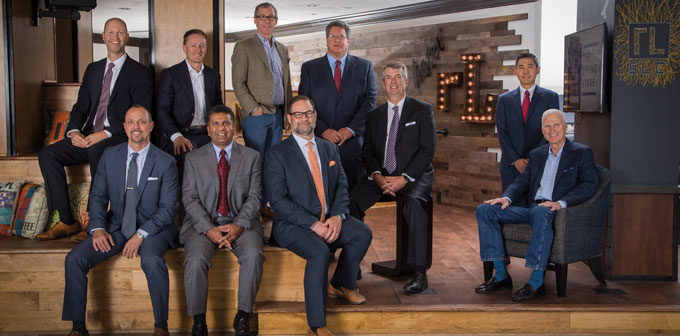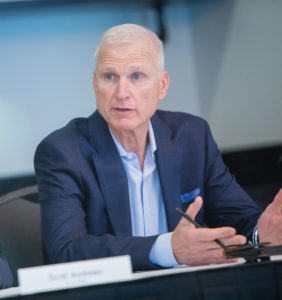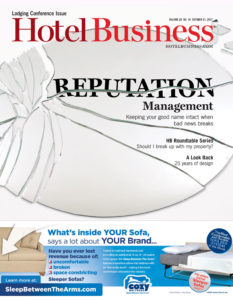Calling it quits can often be a good solution
SALT LAKE CITY—We’re all familiar with the song “Breakin’ Up is Hard To Do,” but sometimes, though difficult, it is necessary. Yes, there are times when it’s best to call it quits to avoid additional loss (whether it be emotional or financial). Knowing when and how to break up can help streamline the rather lengthy (and sometimes agonizing) process. As for how this all applies to real estate, the tale’s often similar.
Held at Hotel RL by Red Lion Salt Lake City, a 394-room property situated in downtown Salt Lake City—right down the road from the city’s Trolley Square—the Hotel Business Executive Roundtable welcomed industry leaders from across the country to discuss the following topics: red flags to consider before continuing to move forward with a property or brand, headwinds impacting both legacy and new brands, and situations where saving a property would be in the parties’ best interest. Real estate risk management firm Arthur J. Gallagher & Co. R.E sponsored the roundtable, which consisted of 10 panelists in total.
To kick off the morning’s two-hour discussion, moderator Stefani C. O’Connor, managing editor of roundtables at Hotel Business, posed the opening question to all: “If you have a brand that you want to move on from or you have a property that may or may not be doing so well, what are some of the flags that make you start to shift your thinking about your hotel or your property or what you’re operating?”
Fifteen-year lodging veteran Kirk Pederson, president of Kokua Hospitality, a San Francisco-based hospitality management company, answered O’Connor’s inquiry bluntly: “If you’re paying attention, the guest is definitely the lead indicator. If you’re paying attention, the guest is telling you. They’re not stupid. You can only hide it for so long, right? I think what we find a lot of times with an aging product [is]the consumer will stay with you for a while because they’re loyal, but you can only hide that for so long. Ultimately, they’re going to make that decision and go somewhere else.”
On the same page, 25-year hospitality industry veteran Bill Linehan, EVP and CMO at Denver-based RLH Corporation, pointed out how all the indicators are transparent; nothing’s hidden from view anymore. “When you look at reputation scores and semantic content, we all see it,” he said. “We no longer need the 50-question surveys for a consumer to tell us their intent to return.” RLH Corporation uses this strategic thinking in practice; there’s a single question on its feedback survey. “Based off of that, we’re getting a lot more feedback from consumers,” he said.
When asked about what makes a guest frown (the survey asks the guest to choose between a smiley face and a sad face), Linehan redirected the conversation—and not in a way to sidestep the question. “Surprisingly, I think it sounds like we’re talking about product, but really it’s about service,” he said. “It’s first and foremost when you fail to meet their service expectations, and then it goes into some of the basics of hotels, and it’s really about cleanliness. Then, finally, it’s facilities.”
If the decision has been made to keep the property, changes more often than not follow, but as far as what needs fixing first, priorities aren’t the same for everybody. “It depends on who you’re asking,” said 25-year industry veteran Mike Hines, chairman and founder of HP Hotels, a Birmingham, AL-based hospitality management company. For instance, if a management company goes to an ownership company for capital, the former learns quickly what’s important to the latter. The outcome is evident when money is being followed.
Brand proliferation has hit the hospitality industry hard; it seems there’s a new brand at every turn. While some executives believe this shows a maturing industry (more options will become available as a result), others feel it’s confusing the industry as well as guests. Andrew Hibbard, VP of finance and investments at Vision Hospitality Group, a Chattanooga, TN-based hotel management and development company, addressed his concerns to his fellow panelists: “How many brands can you put out there for guests to choose from? You can name a handful of brands to just any Tom, Dick or Harry on the street, and are they going to be able to identify those brands? Are they going to know those brands? That’s one thing that gives me some pause.” The segmentation of soft brands also adds complexities.
“How much marketing effort can you put behind any given brand to raise it above the noise? It’s a tough proposition,” he said. “I think that’s one of the things facing us in the industry right now we need to be mindful of.”
What some in the industry tend to forget: Consumers hold the power. They’re the ones who decide whether a brand lives or dies. “We try to look at it from the consumer’s perspective and try to come up with all the different segmentations but, ultimately, whether a brand succeeds or not is whether it resonates with the consumer,” said Greenwood Hospitality Group Principal Aik Hong Tan, who currently engages in the financial and investment disciplines, and growth strategies of the Greenwood Village, CO-based acquisition and management company. “What does the consumer say about that particular brand or whatever the product may be? It’s not what the franchisor or the developer or owner thinks, it’s really from the consumer perspective.” When it comes to developing new brands, all angles and considerations should always be viewed from the consumer’s eyes.
“When you talk about the shiny ball syndrome, who’s chasing the ball?” Hibbard pointed out to the panel. “Is it us, or is it the guest?”
From an investor’s point of view, Michael Cahill, founder and CEO at HREC, a Denver-based investment banking and consulting services, believes “the world is changing in terms of the power of the brand, and what they’re able to do.” For him, technology is changing so fast the brands can’t keep up. Younger generations, millennials specifically, have been approaching travel differently. They no longer look to necessarily be associated with a brand.
“It comes back to when I started doing business in the early ’80s,” he said. “The reason you had brands is you didn’t have access to information, and the brands would provide security in terms of you having confidence in knowing what you’re going to get. I just think the world’s changing.”
Most importantly, these new brands need financing. Where are they to go for funding in this part of the cycle? “I think it’s an interesting time to launch all these new brands because it’s clearly toward the end of the cycle versus the beginning of the cycle,” said commercial real estate lending veteran Scott Andrews, who’s been in his role as managing director of hotel franchise finance at Wells Fargo for three months, in response to the conversation at hand. “A lot of lenders aren’t even offering construction financing. All of these new brands are coming out, but at the end of the day, you have to get them financed. You have to get them built to even prove the concepts.”
As far as financing, he’d prefer funding a property with an established brand. It’s about being able to prove out how a brand’s done in the past. “It’s not to say we won’t try one of the new ones, but it’s going to be a much lower leverage point than we would for a mature brand, a proven brand,” he said.
With regard to a property saving a brand, letting a brand go or moving on to another segment, branding helps itself. “I think a lot of people look for that in any teasers that go out,” Cahill said. Brokers will then ask about the license agreement, renewal probability and the PIP, which he joked about how horrible they can be, admitting his company’s been blindsided by them. “The PIPs are becoming significant in almost every sale,” he pointed out.
For many, the PIPs have become burdensome. “That’s one of the reasons why we’re taking a different approach to it,” Linehan said in response to Cahill’s remarks, noting hospitality groups have become standard happy. According to Linehan, there are two things to ask when it comes to creating a standard: First, does the standard change the evaluation of the hotel? Second, does the particular standard change the guest perception?
“The other issue with the PIP—if you’ve got a list of developers waiting to develop that same preferred brand in that market at a much higher cost, then the existing hotel will have a much higher PIP,” added Imesh Vaidya, CEO of Premier Hospitality, a New Mexico-based hospitality company.
Brands haven’t necessarily been lowering their standards, but they’ve been rethinking them. “For instance, we’re going to be introducing a brand, Country Hearth, that the only standard requirement is ‘x’ score on TripAdvisor, so it doesn’t call for ceilings or carpet or whatever,” said 40-year hospitality veteran Roger Bloss, who joined RLH Corporation as president of global development last year when the company acquired Vantage Hospitality Group. “It’s solely based on what the guest says.”
To bring someone with an investor’s perspective into the conversation, Hines asked Andrews if brand standards matter to investors. “Why would you prefer a core, mature brand?” Hines asked. “Is it because they have those standards in place and have developed a reputation?”
In response, Andrews acknowledged the importance of performance; investors can calculate the average RevPAR, penetration index, etc. “We can underwrite to that,” he said. “The soft brands it’s harder to underwrite to, but a lot of them are doing very well. I think lenders are also learning that, too, as more and more of these soft brands come out. They do very well in the CBDs.” The probability of success is greater in high-density markets.
There are times when a property’s kept because of location, despite the location’s red tape. “The local governments have been extremely difficult to work with,” said Vaidya, speaking on a particular property. “Their requirements on the look, the color, the parking spaces—I have to have a bicycle storage built at this hotel. They can dictate, so between the brand standards, the local standards, it adds costs, [and]it adds time, but these are markets that are basically high-cost barrier markets or space-limitation markets, so we will have to put up with it.” Others have had similar issues.
“We tried to get into a market, and if this table said Home2 or Homewood Suites, what would be the first things to come to mind, everybody?” Hines said. “Good brands, good clientele… The city government looked at [the brands]and said that’s extended-stay; they bring in a wrong type of clientele. It could be any extended-stay product, and all of a sudden these municipalities think that it’s a bad thing.”
Municipalities can pick and choose, however, because, currently, times are good. “They all want full-service,” said Pederson. “They’re not in the business; they don’t see what it costs and what their returns are in the market and everything else, so they’re going to block every one of those select-service or extended-stay products you’re trying to bring into the market.” When times are tough, municipalities will change their minds.
Another issue with municipalities is they look at hotels as a low-paying jobs generator. “Another stereotype we face as an industry is that hotels bring low-paying jobs,” said Vaidya. “It’s a stereotype that we’re always fighting.” Finding these jobs aren’t easy, thereby putting pressures on properties.
“It’s not a sexy business anymore,” Hines said. “I started out waiting tables, so now I own a hotel company. That mentality’s not out there. We’ve got kids coming out of school that have a degree, and they want to make as much as somebody who’s been in the industry for 30 years, and they only want to work five days a week, and we’re a [24/7] business. It’s getting more and more difficult to convince certain people to get in.”
Vaidya responded, “Unfortunately, we’re introducing new brands targeted to these people who are not loyal at all,” which was met with laughter from the panelists. “We can’t get them to work for more than a year and a half, and we expect them to return to the same brand over and over.”
Newer brands, though, can also push the limits of legacy brands, indirectly assisting with the latter’s overall growth. “Maybe all the new brands are forcing the older brands to reinvent themselves, and the branding will be better in the long run,” said Brent LeBlanc, SVP, Peachtree Hotel Group, an Atlanta-based hospitality group. For instance, when LeBlanc and Linehan were at Starwood, the two executives were tasked with putting Alofts near Marriott Courtyards and Residence Inns.
“I think it forced Marriott to go back and rethink what Courtyard was because you had the new, shiny Aloft coming right behind it,” LeBlanc pointed out to the panel. “I hope that the Marriotts of the world, now that they have the Alofts, don’t take their eye off the ball of the Courtyards of the world because they’ve got mass scale. They’ve got an institutional buyer at the end or an exit from the property.”
Legacy brands also run into consistency issues. The more properties out there, the more likely there’s a discrepancy—unlike with newer brands. “I think, as a result, [hospitality groups]think about this, and then they say, ‘Let’s launch the next new one,’ a subsegment of that segment,” Tan said. Brands, especially newer brands, spend so much money on marketing to consumers, even though guests aren’t searching for brands when booking.
“Have we asked ourselves, ‘How are consumers finding hotels?’” Tan said. “If they’re not loyal to a particular brand, they’re not going to brand.com. They’re going to TripAdvisor; they’re going to Google. They have the marketing power. They’re capturing them, and here we are spending all this money on the brand, while they’re coming to us through those channels.”
As always, with any industry discussion, home-sharing rentals made an appearance. “One of our biggest segment competitors is Airbnb because there’s a different experience every time you go somewhere,” Hines said. Not every Airbnb experience will be positive, but Airbnb will at least provide uniqueness. “It’s kind of like the same thing with all these brands, some of them are okay, and some of them will be off the charts,” he explained.
Will these consumers shift to newer brands as they age and become seasoned business travelers? “Is there a new brand that’s going to step up and take the place of the Courtyard, where we all grew up traveling and staying at properties like that, or is it going to be something different?” Andrews said. That’s something hospitality groups will need to eventually figure out.
Another possibility when determining what to do with a property is flag jumping. “It used to be, back in the olden days, you had a full-service hotel box, whatever it was, and then after it reaches a 20-year license agreement, then it moved down in class to the next one, and then it finally moved down to the bottom—until finally it was an independent and condemned going into it,” said Hines, who air charted the chain. “Now, you do the same thing, but you just stay within the same franchise company without jumping out of it.”
In response, Linehan, said, “Well, it’s interesting. We’ve seen several instances and have even compiled case studies where a hotel that was formerly part of a larger system and one of multiple properties in the same market tract as others with the same brand was required to complete a PIP without any opportunity for rate lift because of preconceptions in the marketplace. Alternatively, we offered the opportunity to change their brand and remove the rate ceiling that previously limited their RevPAR. We’ve seen a number of those instances, so where there is brand saturation or inventory saturation off the system and there’s PIP pressure, that indicates an opportunity to look at other brands and options, providing there is a window within their terms as well.”

The host and sponsor of the roundtable, left to right: Roger Bloss, Bill Linehan and Jon Ketover, RLH Corporation; and Jackie Collins and Bob Donoghue, Arthur J. Gallagher & Co.
More often than not, there’s an exit strategy from the beginning; it’s not an afterthought. “Most of the time, every deal you go into you have an investment objective in mind,” Tan said. There may not be a day-to-day timeline for the asset per se, but there’s typically an overall goal (e.g., holding on to an asset for a set amount of years, or maybe even a year range).
“Exit is pretty critical because when you have a hotel investment, it’s not only an exit for the current owner but it’s the exit for the buyer,” Cahill said.
He continued: “One of the most difficult properties to sell is something that’s 15 years into its initial 20-year license, looking to do a PIP to get a 10-year extension because that buyer’s then thinking, ‘What’s my exit?’ What happens is then they’re always worried about who’s the guy that’s going to take that value hit when that hotel finally goes down the branding scale and takes that hit on value, and that’s what everyone wants to avoid.”
Sophisticated exit strategies are making their way down to family-owned companies, which is why they, in particular, need more brands. “We’re going to let some of the older assets go, and now we have to put that income somewhere, so now we need another brand,” Vaidya pointed out. When it comes to disposing of properties, the PIP can ultimately be a deciding factor.
“Most of the times the PIP is extensive enough to where it’s cheaper to build a new-build, a new flag, the latest prototype rather than to put lipstick on an old pig,” he said.
As far as which major factor comes into play when deciding whether to save a property—even if that particular property’s surrounded by competition and is situated in a declining market—the overwhelming majority of the panelists agreed with Bloss’ response: “It’s always location.” HB
Check out our video interviews at video.hotelbusiness.com






